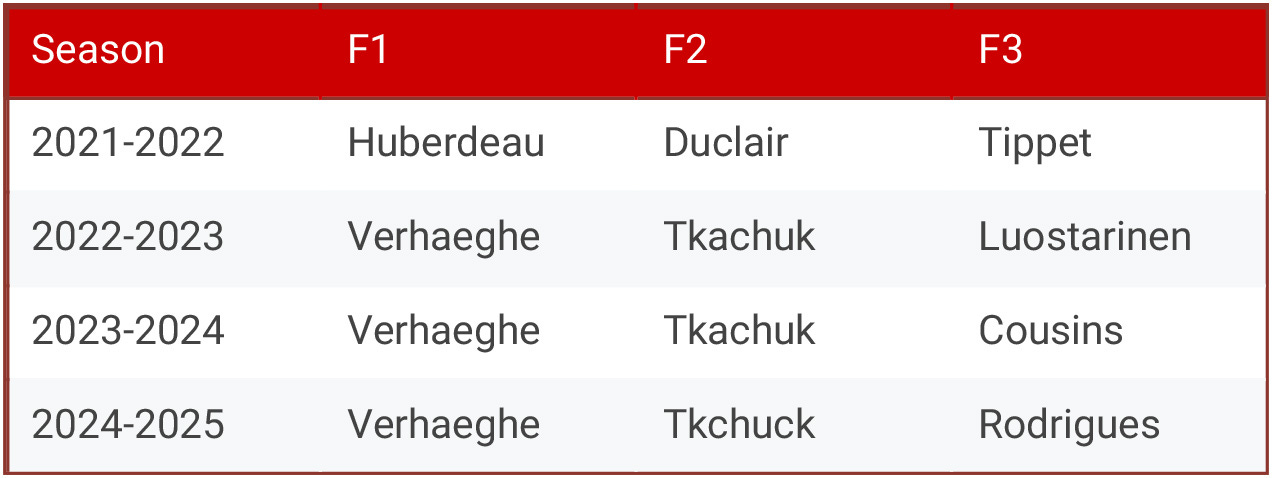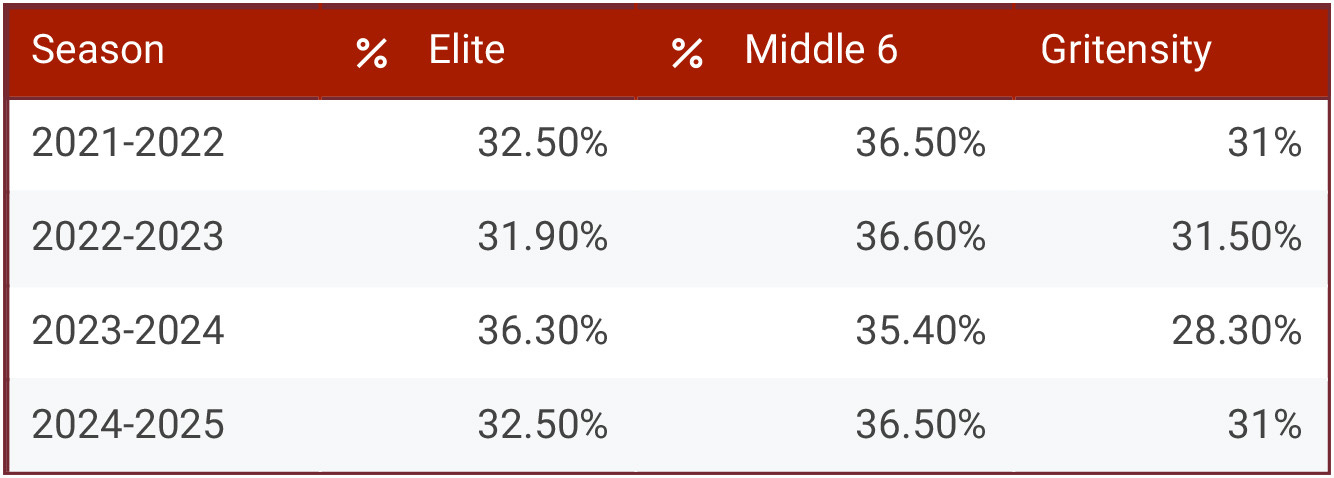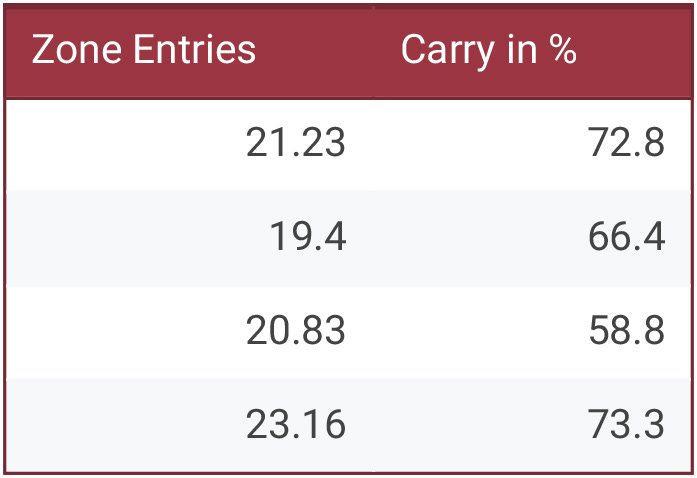Is Sam Bennett a $10 million per year player in 2025?
Sam Bennett is having a great postseason on a team poised for three straight cup final appearances and poised to cash in, is he worth it?
NHL free agency is the closest the sports world gets to grocery shopping while hungry. Just like perusing down the cookie aisle with an empty stomach, NHL GMs are faced with options to sustain their appetite for roster improvement. Similarly to the shopper that leaves the grocery store with cookies, chips and doughnuts, GMs often leave July 1st with players that will meet a certain baseline desire, but burnout just as quick as a sugar high.
The economics of the NHL at large often cull the free agency crop long before teams and agents start backdoor tampering. If a player is worth keeping, a well run hockey team will cut salary somewhere else in the interest of creating room to extend the pending free agent. This in turn often makes the best free agents available to be more niche or specialized skillsets.
The league’s salary cap and structure often mean that the best players available are depth pieces for higher quality teams. High-end players sustain the quality of their respective teams in the long-term, meaning that those teams are more likely to let their bottom six forwards and bottom pair defensemen walk in free agency. There simply isn’t enough money to go around to keep everyone and teams are more inclined to try and figure out the supporting cast around great players than rolling the dice on needing to acquire a better player down the road.
Take for example the brain drain of the Tampa Bay Lightning over the course of their three Stanley Cup final appearances. The league’s COVID-19 induced cap crunch meant that the Lightning had to part ways with Blake Coleman, Yanni Gourde, Barclay Goodrow, Ross Colton, Ryan McDonagh, Steven Stamkos, Mikhail Sergachev, Alex Killorn and Ondrej Palat in a short period of time.
Of those players, Goodrow, Colton, Stamkos, Killorn and Palat all got bigger paydays with other organizations. Driven by the feeding frenzy environment of July 1st where GMs feel obligated to leave the day with something to show both their owner and fanbase, it creates a service seller’s market. While Killorn, Palat, Colton and Goodrow didn’t have the bonafides to be top six forwards on Stanley Cup contenders without stronger line mates, that didn’t stop their new teams from trying their best.
This brings us to the looming unrestricted free agent status of Florida Panthers forward Sam Bennett. The former 4th overall pick of the Calgary Flames way back in 2014 is in the midst of a career season and a culture setter for a Panthers team one win away from its third straight Stanley Cup final appearance. Bennett is a throwback player that NHL GMs and media figures adore for his ruggedness and willingness to play with a reckless abandon.
At 28-years-old, Bennett is in the prime of his athletic life and poised to turn this career best season into a life altering, generational amount of wealth. Of course, this poses a natural question: Is Bennett a steak or is he a box of cookies?
Environment vs talent?
In the grand scheme of player evaluation, understanding a player’s environment, is imperative to glean just how valuable they are as an individual. Far too often, teams are glad to throw money at their problem the first day of free agency to chase an intangibles laden veteran from a former Stanley Cup winning team to buy themselves some instant credibility. The problem with that bolt on mentality is that Bennett’s experiences don’t get transferred to the rest of the team through osmosis. The GM simply added an experienced player to a group that needs more of it to go around.
To start the conversation, it’s important to note that the Panthers have consistently been amongst the league’s best teams over the last few seasons. That framework is important to start from because while Bennett wasn’t a schlub with the Flames, he’s taken a discernible leap in his play and production as a Panther.
The single biggest driver of counting stat (goals and assists) production in hockey is ice time. The more a player plays whether it be at 5-on-5 or the power play, they have more opportunities to contribute offensively. It’s not a coincidence that in a season where the Panthers best winger, Matthew Tkachuk missed 30 games, that Bennett would have an opportunity to fill that void.
In Tkachuk’s absence, it would only be natural for Bennett to get the most ice time of any season in his entire NHL career. A almost a full minute more per game at even strength and of power play time is so much more opportunity for a strong, well rounded player like Bennett to contribute to creating offense.
Bennett’s previous career high in points (49) came during the 2021-2022 season where he rode shotgun with Jonathan Huberdeau who finished as a Hart Trophy finalist that year. For Bennett to hit the point total he did, 40 of his 51 coming at even strength with one of his most common line mates, Carter Verhaeghe, having a down year is all the more impressive.
The last factor to consider in evaluating Bennett’s role and environmental context is the quality of his competition. There’s something almost fitting that in Bennett’s two highest point total seasons as a Panther that he had the exact same minutes allocation. It’s not just anecdotal to say that Bennett is at his best against the world’s best.
Under the hood
Building out a usage profile is a crucial component for projecting a player’s fit with a hypothetical new team. So much of free agency is wish casting, based on what a player could do in relation to what they’ve already done. That’s why it’s important to understand what makes a player successful before offering a max term contract with full no-movement protection, especially if a team is going to utilize them in a more prominent role as a means of justifying their gaudy contract.
With a baseline understanding that Bennett is playing more minutes, getting first power play usage and still had 78 percent of his points at even strength demonstrates a player that isn’t of the most high-end skillset but still has plenty of utility. Of course, a team that signs Bennett on July 1st is going to want to give the Team Canada forward an opportunity to put up counting stats with a role on its first power play unit.
But, at five-on-five Bennett’s numbers really sparkle. While he benefits from playing on a Panthers team that is consistently one of the highest tempo and possession teams in the entire NHL, his numbers both on a rate and percentage basis are of high quality.
Scoring chance: goals, shots on goal, missed shots, blocked shots
Shots for: Goals, shots on goal
The Panthers’ preferred style of play and Bennett fit like a glove. His natural tenacity and high motor allow him to thrive in the frenetic, overwhelming style Florida’s employed to three straight Stanley Cup finals. Looking at the relationship between scoring chances and shots on goal paints the picture of Bennett’s lines controlling play steadily and using a volume based approach to wear opponents down.
While normally a wide gap between scoring chances and shots on goal means a team is leaving offense on the table via efficency, it’s hard to argue with Florida’s results with Bennett on the ice over the last four seasons.
GF: Goals for
GA: Goals against
xGF: Expected Goals for
xGA: Expected Goals against
On top of controlling the volume of possession, the Panthers consistent puck control allows for a dominant share of offense in Bennett’s minutes. On a rate basis, the Panthers have created slightly less offense in Bennett’s minutes year by year as the team’s style of play transitioned more towards a volume based offense, the team’s shooting percentage has dipped, meaning the team converted fewer chances.
But, on the whole, the team’s expected goal share staying within a three percent range over a four year period is reasonable enough proof that even though the team is scoring goals at a lower rate, the volume of possession is enough to sustain a reasonably high rate of expected goals.
While expected goals cannot yet capture pre shot motion of goaltenders or the puck, it is a good snapshot of where scoring chances are physically coming from on the ice. Expected goals is a measure on how likely a shot is to result in a goal based on historical data. Meaning that a scoring chance’s expected goals value is on a sliding scale of 0-1. The more likely a chance is to result in a goal, the higher the number and closer to 1.
A high rate of low quality scoring chances is a means of gaming the expected goals system. Of course, teams aren’t actively trying to manipulate their expected goals totals, but when it comes to evaluation, it’s a useful framing for understanding how a team plays in practice.
High danger chance: A chance within the hashmarks to the posts of the goalie’s net
On ice shooting percentage: The shooting percentage of Bennett and all his line mates during their 5-on-5 minutes
The last component of shot metric evaluation to consider is how dangerous the offense Bennett and his line mates produce is. Interestingly, for the first time in Bennett’s career as a panther, his high danger chance share went below the 50 percent mark, meaning opponents had more than half of the high danger chances in his minutes.
Again, tying the Panthers transition towards a cycle, volume based offense team is the 7.53 on ice shooting percentage. For context, the NHL average in the regular season for 5-on-5 on ice shooting percentage was 8.96. While 1.43 percent over the course of an 82 game regular season might not seem like a huge gap, for a volume based offense that doesn’t produce as much quality, that can be the different between winning and losing in a small sample size.
Transition
One of the key factors in deciding as to whether a player is a driver, colleague or passenger is how they go about creating their offense. Some players have the natural speed or positioning ability to create zone entries for themselves and their line mates which inherently make them more valuable than a forward who needs someone else to carry the puck for them to be effective.
This role is unsung, the puck carrier that offense flows through doesn’t get enough credit. Only the most craven of data heads are monitoring Corey Szjneider’s All Three Zones project to evaluate the nuts and bolts of hockey. If offense and defense are the bones and muscles of a hockey team, think of transition play as the ligaments and tendons that allow complex, multi-faceted movement.
When it comes to Bennett, his puck carrying skills stand out, especially on a Florida team that has the third highest rate of its offense come off of the cycle and forecheck.
So, not only did Bennett carry the puck into the offensive zone with control at the highest rate of anyone on the Panthers this season, it shows a high level of trust from the coaching staff. For Bennett to actively play a different style of hockey than the rest of the team and for it to work at a high level shows a coaching staff that understands how to get the most out of the former first round pick.
On top of carrying the puck into the offensive zone with control, Bennett also has a proclivity for offensive creation. While he skews towards shoot first, he’s not by any stretch a puck hog or someone the play dies with. If anything, Bennett’s versatility as a puck carrier in transition opens up more space for his line mates to find and subsequently make themselves available for a pass.
Comparing the rate of shots to scoring chances shows a player in control of play when on the ice and comfortable in a variety of environments. It’s not a coincidence that Bennett was selected to team Canada for this past Winter’s Four Nation’s Face off with the mindset of being a plug and play Swiss Army knife that could be deployed in any situation while maintaining effectiveness.
What’s it all worth
The hardest part of pricing Bennett’s value fairly is trying to understand how he’ll fare away from the buzz saw in the midst of its third straight Stanley Cup Final appearance. While Bennett’s raw skills will stick with him should he choose a new sweater and an eight figure contract, their effectiveness may wane without the exact fit Florida offers.
My golden rule for player pricing has always been $1 million dollars for every ten points and $1.5 million for every ten goals. This starts the pricing argument within a reasonable scale and its translated well to an era of limited economic growth on a league wide scale. As the NHL finally gets to tap into some of its new TV deal money and raise the salary cap at a commiserate market rate, my limited growth pricing system loses merit.
In a relatively flat cap environment, every last bit of cap space was at a premium. The salary formula was a means of weeding out non-measurable traits that somehow always ticked the price up or ensured no-trade protection of some kind.
For argument’s sake, using the formula ($1 million for every ten points, $1.5 million for every ten goals) that would make Bennet worth $8.75 million based on his career best 2024-2025 season. At face value, that still seems a bit rich for a 51 point forward in relation to the grander market, but it’s important to account for the salary cap increases on the horizon.
As time moves on, with the cap increasing regularly, it’ll be more constructive to think of cap hits as percentage of the cap as opposed to the AAV because the price points will consistently reset as the latest player to get paid is going to push the upper boundary for what they can earn.
In that case, against next year’s proposed $95.5 million salary cap, the hypothetical Bennett hit of $8.75 million would come in at 9.2 percent of the total cap. For context, that would sandwich the Panthers’ forward between Matthew Tkachuk’s 10 percent and Sam Reinhart’s 9 percent. It is also worth pointing out that Tkachuk and Reinhart’s respective career high’s in points are 109 and 94 respectively.
Those figures represent the upper 1% of all NHL player output. Over the last five seasons, just 19 different players have hit the 100 point threshold that is almost double Bennett’s career high set this year.
Unfortunately for speculative Bennett buyers this July 1st, his non-measurable stats won’t manifest in the box score. As gritty and tenacious as he is, just 16 active players in the NHL made at least $10 million per year. All due respect to Bennett who is having a remarkable run of form as a key cog on a potential dynasty, he is not a top 40 player in the NHL, let alone top 20.
If you’re wishfully casting Bennett’s value against an increasing cap, it does become more palatable. The proposed cap ceiling is supposed to go from $95.5 million all the way up to $113.5 million in 2027-2028. At ten million per year, Bennett would come in at 8.8 percent of the cap. Rich for a maybe .6 points per game ceiling player, but the perceived value of his non-measurable stats might push him over that finish line.
NHL teams are more inclined to chase non-measurable traits in free agency than the other major sports because of the sport’s cap ceiling. With time, teams will have the option to employ more skilled lineups that are more costly as the salary cap rises or they’ll overpay for checking wingers to kill penalties.
Either way, Bennett is likely an eight or nine million dollar per year player peaking in a walk year against the backdrop a rising market for labor. I wouldn’t feel good if my favorite team signed him for more than $8 million per year based on his age and production, but thankfully New York Rangers general manager Chris Drury has never overpaid for former Stanley Cup champions.
Oh. Wait.
Get ready to learn Bing Bong Sam Bennett.












